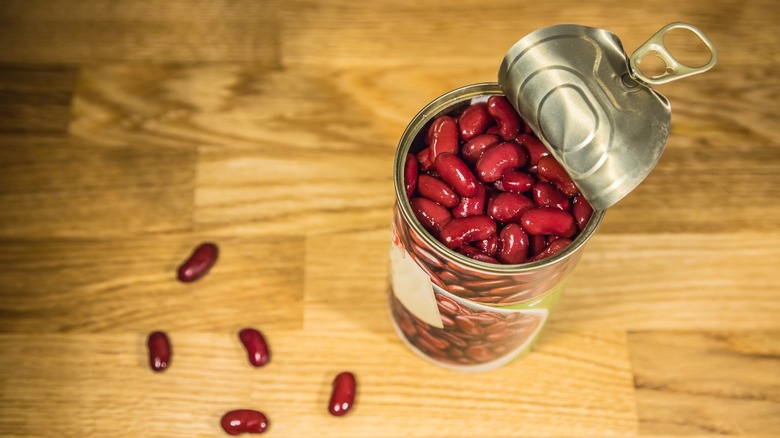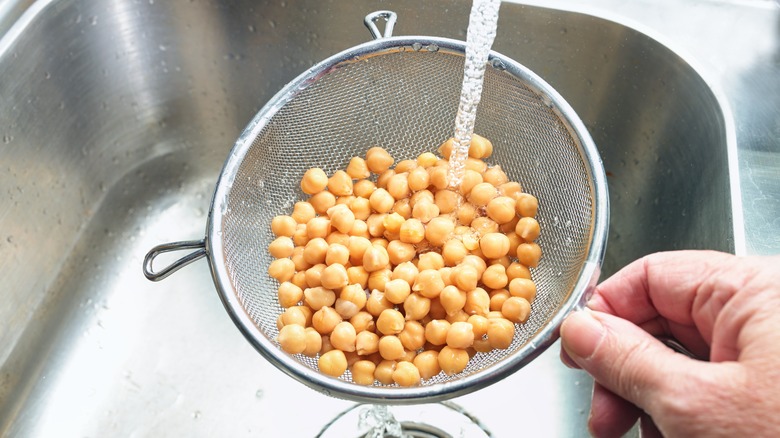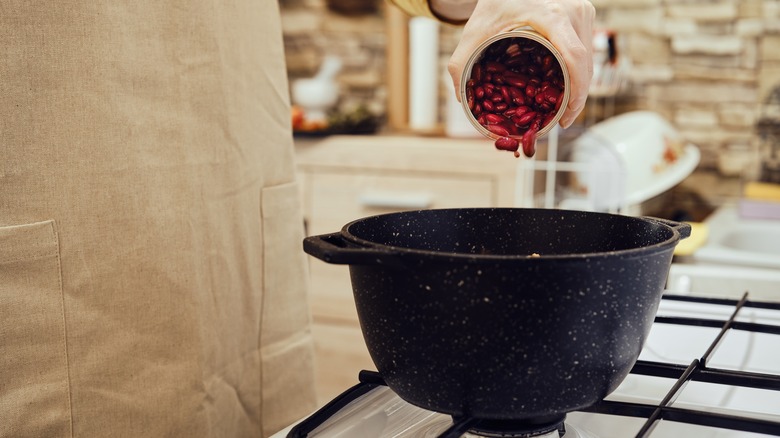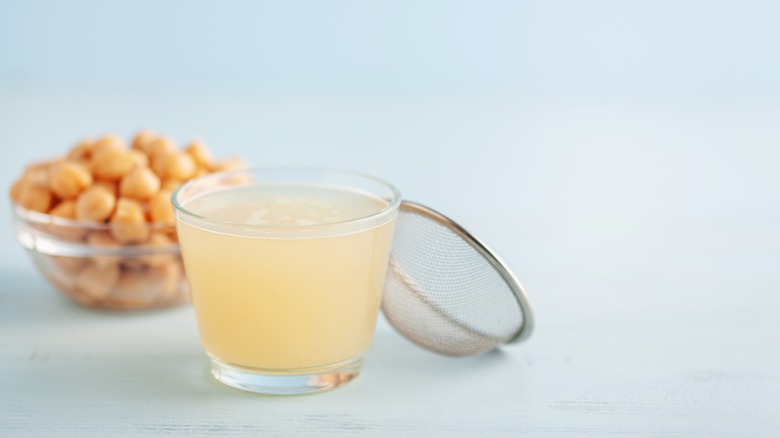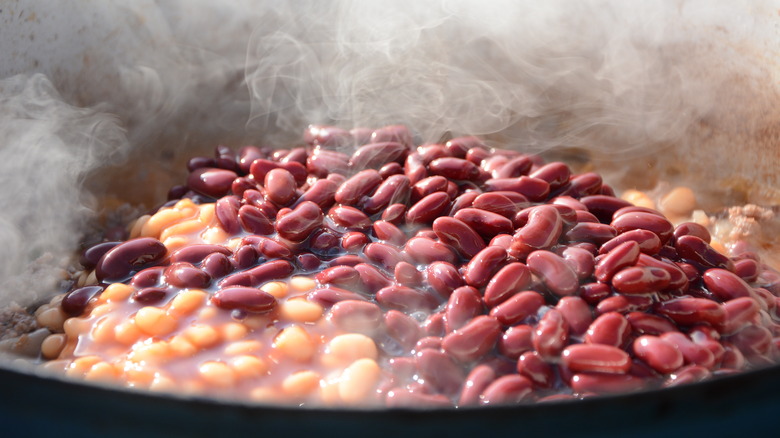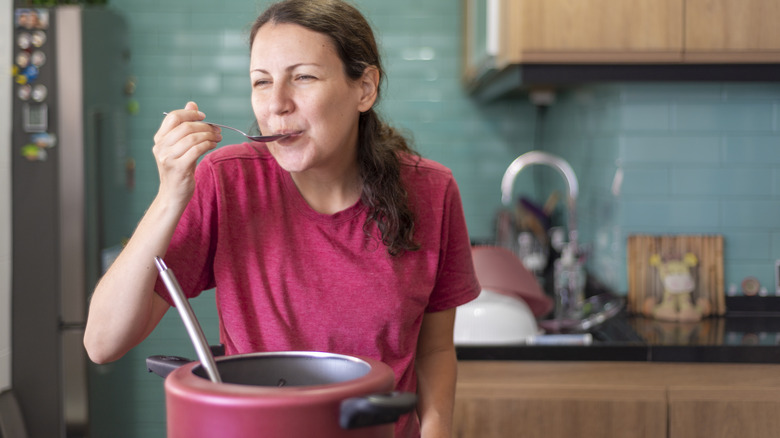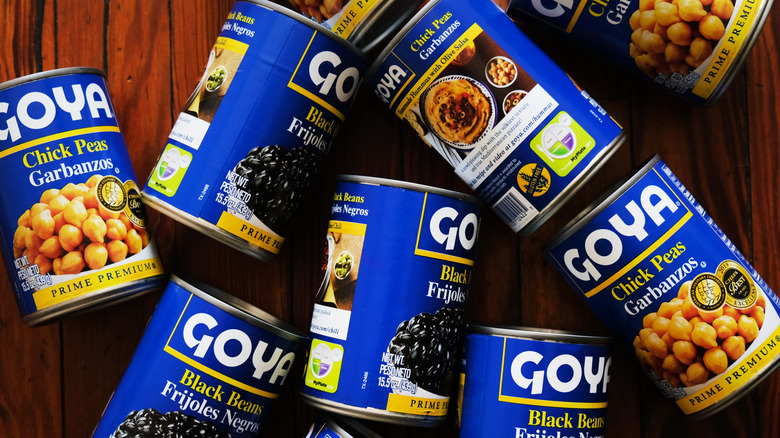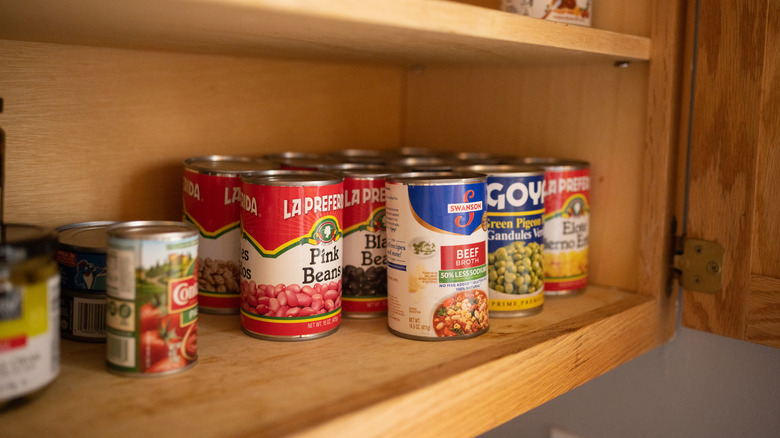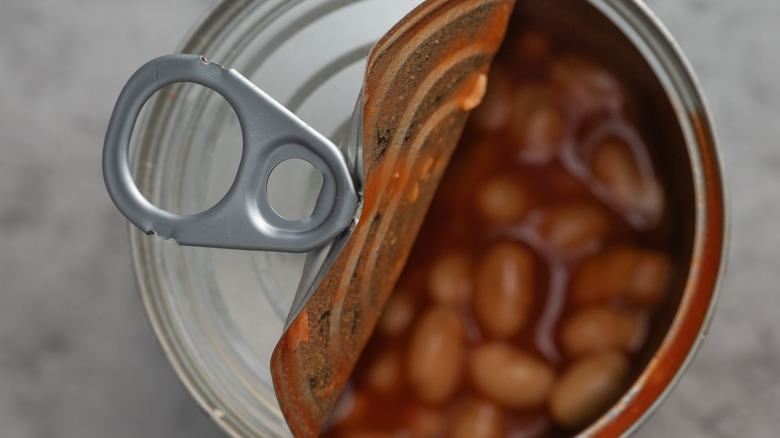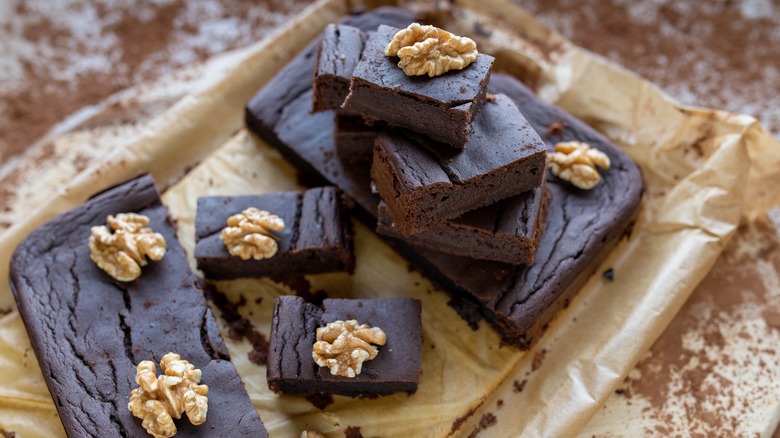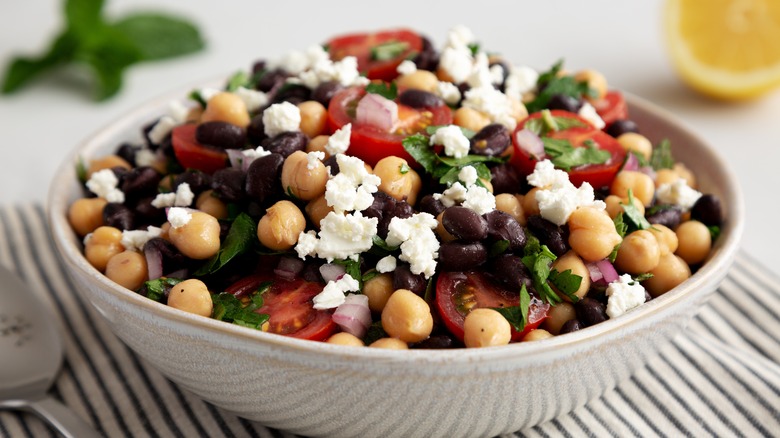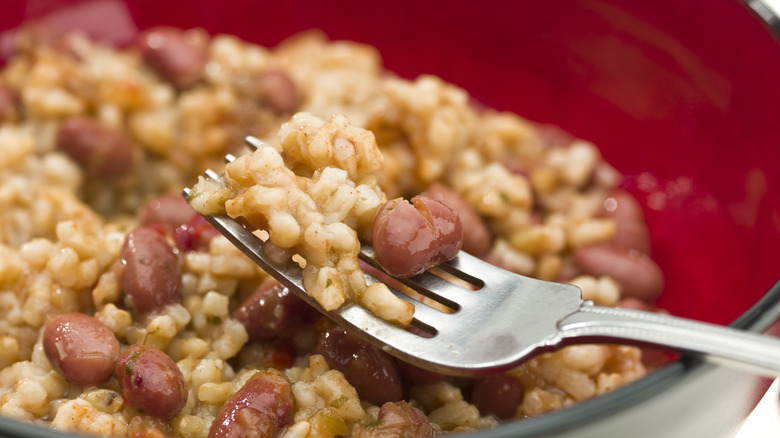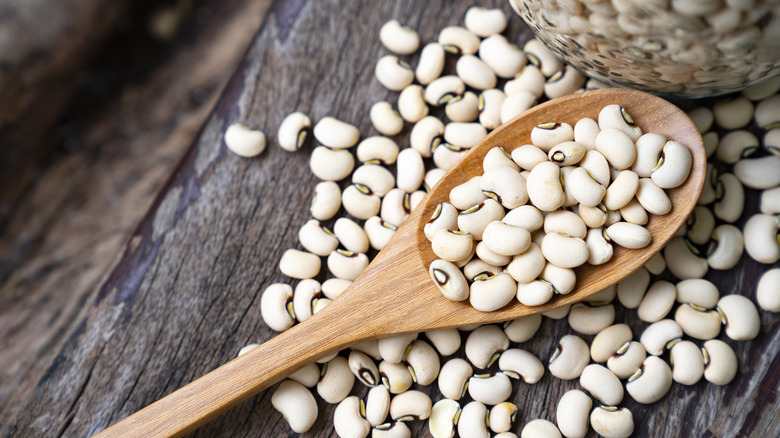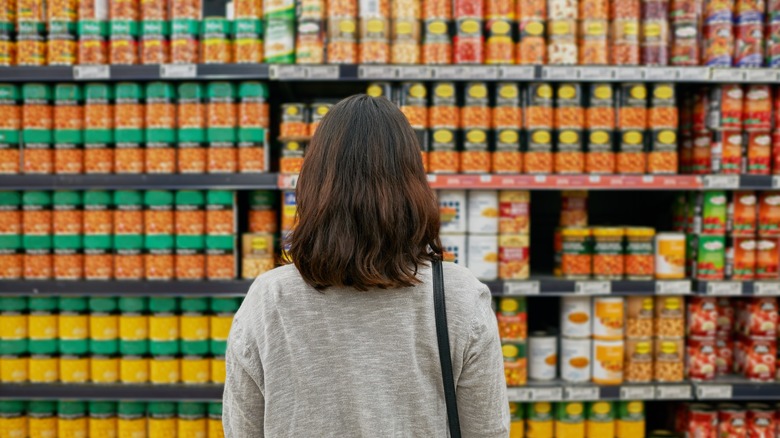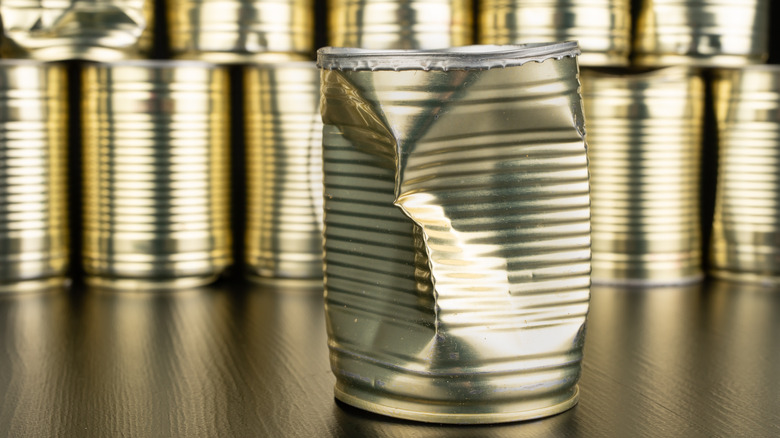Common Mistakes You're Probably Making With Canned Beans
It's a can of beans. How hard can it be? You pop it open, pour the beans into a saucepan, heat them up, and chow down. Well, maybe that's simplifying this extremely versatile ingredient a little too much. The mighty canned bean can be a boon to your pantry, providing you with a nutritious side dish in a pinch, a protein boost to salads or soups, or a cheap eat when you're trying to stretch your grocery budget as far as it'll go. Don't even get us started on the extensive variety of beans you could buy. Black, kidney, navy, white, cannellini, baked, pinto — the list goes on.
However, for all their benefits, canned beans do come with some potential pitfalls. If you're making some of these common mistakes that home cooks commit all the time with canned beans, you could be setting yourself up for a disaster. Not only can these mistakes result in a less-than-tasty meal, but, in some cases, they could also lead to food-borne illness — and no one wants that. Here's what to avoid and how to make the most out of every can of beans, no matter your preferred variety.
Not rinsing them
First things first, before you add that can of beans to a favorite dish, whether you're mixing them into a chili recipe or a three-bean salad, you need to give them a rinse. Yes, while you probably know to rinse your pasta and your rice, canned beans need rinsing, too, even if most other canned foods do not require rinsing (unless you're trying to wash off excess added sodium). In fact, most canned beans will instruct you, right on the can, to rinse the beans before consuming.
Why is this a necessary step? In an interview with Mashed, blogger Sunita Yousuf of The Wannabe Cook said that rinsing your beans could remove some of the preservatives that help make the product shelf-stable. Additionally, in the same article, Eric Sornoso of Mealfan told Mashed that rinsing your beans could help to reduce unwanted, metallic flavors. The only time you might forgo the rinsing is if you need to thicken a recipe, which the thick liquid in a can of kidney or black beans can help with.
Overcooking them
If you've ever cooked dried beans, then you know that the process can be quite lengthy. In addition to soaking your dried beans overnight, in a bowl of water, you'll also likely have to let your dried beans simmer on the stovetop for multiple hours. The beauty of canned beans is you don't have to do any of this time-consuming work. The beans are cooked as soon as you open the can.
That said, most home cooks are adding their beans to another recipe that they're cooking — and that's where you can run into the problem of inadvertently overcooking your beans. Try to avoid cooking your beans for more than 30 minutes, and make sure you're doing so in extra cooking liquid, particularly if you drained and rinsed your beans. Otherwise, you could end up with dried out beans that have begun to lose their texture. You really only need to cook your canned beans long enough to ensure that they're heated through, which might take only 10 to 15 minutes.
Throwing out your aquafaba
If you've yet to become acquainted with aquafaba, it's high time you met this amazing ingredient. Whereas the liquid you find in a can of black beans or kidney beans can be tossed without a care, the liquid that you find in a can of garbanzo beans, or chickpeas, is liquid gold, aka, aquafaba.
What exactly is it and how can you use it? Aquafaba is technically the liquid leftover after boiling beans in water. However, since the experts have found that aquafaba is superior when sourced from chickpeas versus any other legume, aquafaba has become synonymous with the liquid left behind in your can of chickpeas. The liquid, which is chemically very similar to egg whites, almost magically foams and whips just like an egg white, so you can use it to make meringues, macarons, and egg-free baked goods, among other uses. The next time you open up a can of chickpeas, save the aquafaba left behind. You can store the aquafaba in the fridge for a week or freeze it for later use.
Not seasoning them enough
Yes, most canned beans come with added salt and you can buy some canned beans pre-seasoned for use in chili and similar dishes. However, most cans of beans will still need a little extra seasoning love, once you crack them open.
Adding extra flavor to your canned beans can start with your cooking liquid. Remember how we said that you need to add just a little extra liquid to every can of beans, during the heating process, to ensure they don't dry out? Opt for broth instead of water, for extra flavor. You can also add a little olive oil, toss in some minced garlic or finely diced onion, and let those flavors meld. If you don't want to do any extra dicing or mincing, simply grab a few items from your spice rack. Depending on the flavor profile you're going for, common spices and dried herbs like paprika, cumin, chili powder, thyme, oregano, rosemary, or sage will all work well.
Over-seasoning them
On the flip side of this, it's also possible to over-season your canned beans. Most canned beans have a relatively mild flavor profile, so keep in mind that drowning them in chili powder, paprika, garlic, and onion could leave you with a batch of beans that tastes like your chosen seasonings and spices, with little room leftover for the beans themselves.
If you're eating the beans solo, and not adding them to a larger dish like a soup or salad, opt for simplicity. Choosing just a few ingredients to add can be enough to make a big difference. Sometimes, even just cooking the beans in broth versus water can be enough to leave you with a simple, savory side dish. If you add garlic and onion, just go with garlic and onion. If you dice and sauté some bacon and then warm the beans in the bacon fat, don't pour on a bunch of extra spices or salt. If you want to go lighter, try lemon juice and one or two fresh herbs. In short, don't overthink it.
Using beans with added sodium
Eating a cup of average canned black beans comes with more than 10% of your recommended sodium per day, due to the added sodium. Rinsing and draining that can of black beans will help remove some of the sodium, but it won't remove all of the sodium. According to the Northarvest Bean Growers Association, studies have found that draining a can of beans removes about 36% of the sodium, while draining and then rinsing a can of beans removes about 41% of the sodium.
That considered, in the best case scenario, if you drain or rinse the can of beans referenced above, you're still getting about 154 milligrams of sodium per cup, so about 6.6% of your daily recommended sodium intake. Additionally, often, you're not just eating the beans, unseasoned, from the can. You'll probably add extra sodium via actual salt, broth, or other ingredients, and so the sodium in each serving increases further.
You can avoid all of this by simply buying canned beans that are labeled "no added sodium." This allows you to more accurately control the amount of sodium in each serving.
Storing unopened cans of beans incorrectly
You might not give all that much thought to how you store your canned goods once you bring them home from the grocery store. Just take them out of the bag and toss them into the pantry, right? However, how you store your canned beans can directly impact how long they remain safe to eat, regardless of the best-by date on the can.
According to the U.S. Department of Agriculture (USDA), while low-acid canned foods like beans can typically last two to five years in ideal conditions, you might easily be storing your canned foods in less-than-ideal conditions and not even realize it. The USDA recommends storing canned beans in a cool, dry location, avoiding cabinets over the stove or under the sink. Damp areas, as well as locations that experience extremely high or low temperatures, should also be avoided. Even with ideal storage conditions, though, before you pop open that can of beans, be sure to give the can a once over; dented, leaking, or bulging cans are a sign of botulism-causing bacteria.
Storing opened cans of beans correctly
But what about once you've opened your can of beans? Do you really need to worry about how you're storing them at that point? Yes, and, again, it's all because you want to avoid any nasty food-borne illnesses.
You can store leftover canned beans in the fridge for three to four days. However, don't store them right in the can. Instead, toss the can and transfer the canned beans to a plastic or glass container, with a lid. Signs that your beans have gone bad include a mushy or slimy texture, a sour odor, or discoloration or mold. The sooner you can eat your leftover canned beans, the better. If you don't think you'll be able to eat them in three to four days, you can always freeze the leftover beans, in an airtight and freezer-safe plastic or glass container. There, they can last a month or two before they begin to deteriorate in texture and flavor.
Forgetting to use them in your baking
If you're overlooking all the great ways you can use beans in your non-savory dishes — specifically, in your baking — then you're missing out. Adding beans to your baking products can provide extra protein and fiber, reduce fat content, and replace flour in some recipes. Some of the most popular options include using black beans in your brownies or pinto beans in your cake (in fact, you may've seen trending social posts featuring a 1950s pinto bean cake, in recent history).
Using canned beans in your baking is pretty easy. For a black bean brownie recipe, all you need to do is combine black beans with your typical other brownie ingredients, sans flour, such as butter, eggs, cocoa powder, baking powder, and vanilla, with honey as a stand in for sugar. Similarly, pinto bean cakes ditch the flour and use beans and ground peanuts instead, along with eggs, butter, baking powder and, again, honey instead of sugar.
Not adding them to your salads
If you're thinking "beans" and "salad," you're probably thinking three-bean salad. Depending on your recipe, you might choose a variety of different beans for your specific three, but, whether you go black beans, pinto beans, chickpeas, or any other, you're probably opening up a few cans of beans.
However, don't limit your use of beans in salad to this summertime picnic staple. Beans make a great addition to just about any salad recipe, especially if you're looking for a little extra texture and some additional protein and fiber. Canned beans also make for a more filling and heartier salad, and can stand in for an animal-based protein. Plus, it's an ingredient that requires no prep work. Just open a can, drain and rinse, and add the beans to your salad. Try adding black beans to a southwest salad, cannellini beans to a Greek salad, or kidney beans to a Cobb salad.
Not using them to bulk up a simple meal for cheap
Along these lines, canned beans' versatility make them ideal for bulking up a simple meal for cheap. They go with just about any cuisine and flavor profile and, again, provide protein, fiber, and a rib-sticking quality that make them perfect for adding to salads, soups, rice, wraps, tacos, and more. Have a few can of tomatoes and beans? You have chili. Have rice and a can of beans? You have a staple meal beloved the world over. Have beans, a tortilla, and some cheese? You have a burrito or a taco. With pretty much anything you're cooking, you could add a can of beans.
All the while, canned beans are exceptionally affordable, so there's no excuse not to stock up. With store-brand beans going for under $1 per can, you can easily grab a few other ingredients and craft a quick meal for just a few dollars.
Incorrectly swapping them with dried beans
Given the time-consuming process of cooking with dried beans and the ease of cooking with canned beans, it wouldn't be surprising if you wanted to try a recipe that calls for dried beans, but swap out the dried beans for canned. However, you can't just swap a cup of dried beans for a cup of canned beans and expect the recipe to turn out the same way.
Dried beans' weight and volume increase as they cook — just like rice. So, if you swap dried beans for canned beans in equal amounts, you'll find that your end dish doesn't have quite the amount of bean-y goodness that it should. For best results, use two cans of beans for every cup of dried beans. An average, 15-ounce can of beans contains about 1½ cups of beans, so that means you're subbing approximately three cups of canned beans for every cup of dried beans that your recipe calls for. Additionally, when making this swap, you may need to shorten your recipe's cooking time, such as if it's a soup recipe that includes the time necessary for the dry beans to cook.
Using the wrong beans at the wrong time
While canned beans are highly versatile and bean varieties are very interchangeable, there are some instances where you might want to choose certain types of beans over another. For example, as Eric Sornoso of Mealfan told Mashed in an interview, you should opt to use navy beans, great northern beans, or cannellini beans for baked beans, as they can stand up to a longer cooking time and will absorb your baked bean sauce's flavors well.
Likewise, if you're making a dish that has a long simmer time, like chili, you'll want to opt for a bean that will hold its texture over that time, like a kidney bean. If you'd prefer a bean that's softer, go with pinto beans. If you want a bean that's on the smaller side, but with still a nice bite of texture, for tossing in a chopped salad, try black beans or garbanzo beans. Overall, you should consider texture, taste, and density when picking the right bean for your intended use.
Holding on to a damaged can
You stocked up on those affordable cans of beans and are excited to start adding canned beans to more dishes throughout your daily life — but you accidentally dropped a can as you were bringing in the groceries. It has a bit of a dent now. Should you still hold on to that dented can?
According to the U.S. Department of Agriculture (USDA), whether or not you should keep a dented can isn't always a straightforward question. It depends on a few factors. Firstly, consider the size of the dent. Cans with "deep dents" should be tossed. The USDA defines a deep dent as one that you can lay your finger in, and that will often have sharp points on either side. These deep dents can break the can's seal, allowing bacterial growth. Additionally, look for other signs of damage. If there's any leaking or bulging, toss the can, as it could contain bacteria that can cause botulism. Otherwise, if the dent is small and if you don't detect any foul odors or odd appearances upon opening the can, it should be safe.
